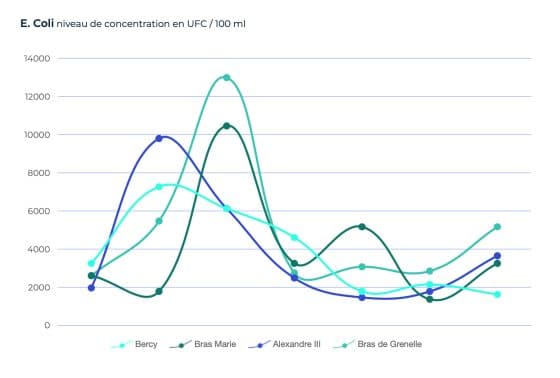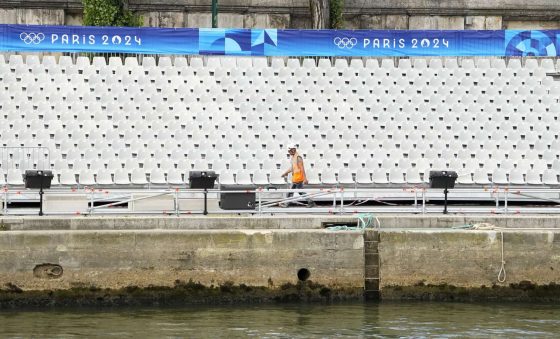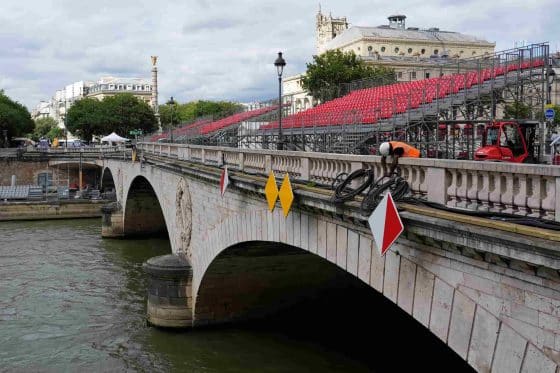Uncategorized
Swimming in the Seine: Diarrhoea, Cramping, Vomiting and Fever – Everything Swimmers Can Look Forward to at the Paris Olympics

The 2024 Olympics are just around the corner, but concerns over the water quality in the River Seine continue to cast a worrisome shadow over a handful of swimming-orientated events.
Competitors in freshwater swimming and triathlon events face the threat of faecal bacteria including E. Coli, which has been found to be up to 10 times the acceptable levels for safe swimming.
Symptoms can range from mild to life-threatening, with diarrhoea, vomiting and a high fever the most common.
No Olympic host has staged swimming in an urban river since 1896, highlighting just how ambitious a project this was always likely to be – particularly in a river as polluted as the Seine.
Even with organisers now assuring the public that the Seine is ready, Sportscasting puts the river under the microscope to see if it will indeed be suitable come the end of July, and how it compares to previous freshwater venues at past Olympic Games.
Key Data Points:
- Dangerous levels of E. Coli bacteria were found in all but one of 14 samples taken between September 2023 and March 2024.
- France has long struggled with suitable inland bathing safety – just 65% of its sites were deemed ‘excellent’ compared with the UK’s 97% in 2012.
- £1.2bn has been spent on a river regeneration project, but contingency plans are in place to move freshwater events to later in the Games.
Swimming Has Been Banned in The Seine For Over a Century
Alarmingly high pollution levels in the River Seine has meant swimming has been prohibited since 1923 – that was until last week when the city’s mayor took the plunge to show just how ready the river is for the Olympics.
Olympic organisers have been eager to use the Games as a turning point in the river’s health, setting in motion a £1.2bn regeneration project that includes reducing the flow of untreated wastewater, as well as a brand new rainwater storage facility.
Above average rainfall has seen water levels rise to around four to five times higher than usual, overwhelming the city’s 19th century sewage system. Combined with very little sunshine and above-average temperatures, bacteria has thrived in the months leading up to the Games.
Even with sizable investment in improving the water quality, the Seine continued to fail safe swimming tests less than a month before the start date.
What Are the Health Concerns Swimmers Are Facing?
Two types of harmful faecal bacteria have been found in all but one of 14 samples taken by water charity Surfrider Foundation Europe.
The most pertinent of which is E. Coli – commonly found in the intestines of humans and animals but harmful strains can thrive on food and in water.
According to the World Triathlon Federation, level of E. Coli was 10 times acceptable levels and at “no point did it fall below the upper limit of 1,000 colony-forming units per 100 millilitres.”

Infections caused by E. Coli can lead to stomach-turning symptoms, with abdominal cramps, diarrhoea, vomiting and an accompanying fever commonly reported by sufferers.
In severe cases, E. Coli infections can even lead to organ failure and death.
How Does the River Seine Compare to Previous Olympic Swimming Venues?
Triathlon and marathon racers are no strangers to battling the elements, but finding places to swim that are free from pollution is increasingly difficult.
It is interesting to note that before the London 2012 Olympic Games, the UK boasted 97.4% of its bathing waters meeting the required standards of cleanliness, according to the European Environmental Agency (EEA).
This was considerably higher than its fellow European countries that were included in the study, which included France who had one of the lowest scores at 65% – perhaps a bad omen for their hosting duties this summer.
However, London still opted to use The Serpentine – a 40-acre lake in Hyde Park – instead of an actual stretch of the River Thames due to alarming levels of pollution.
Four years later in Rio, Brazil’s rivers were contaminated with raw human sewage according to a 16-month-long study by the Associated Press.
Swimmers would encounter 1.7 million times what would be considered worrisome in the United States or Europe. At those concentrations, competitors who ingest just three teaspoons of water are almost certain to be infected.
Americans swimmers Kalyn Robinson and Chip Peterson believe their intestinal ailments may have come from competing in Rio back in 2007.
It seems even if water is deemed safe to swim in, the long-term health risks are a thinly veiled threat.
What Have French Officials Done to Prepare and Will the Seine Be Ready?
At the time of writing, the river has been declared ready – although significant concerns remain.
Officials have been at loggerheads with heavy rainfall in recent months, which has raised bacteria levels in the Seine.
Water quality tests will continue in order to align with the World Triathlon Federation’s threshold. More heavy rainfall could reverse the city’s announcement that the Seine is ready, with sewage systems still at threat of being overwhelmed.
The first stage of a potential contingency plan is to move freshwater swimming events to the very end of the Games.
This would effectively buy organisers more time to ensure water levels are deemed safe, if circumstances change.
Other options include moving marathon swimming to indoor pools, and turning the triathlon event into a duathlon, i.e. just cycling and running.
Water Quality Expert Warns That Events Taking Place Hinge On Rainfall Levels
Dr Nick Hill, who heads up independent consulting practice Water Quality London, says these levels of contamination are not uncommon in heavily urbanised areas.
He told us: “Any urban area which has a combined sewer system (i.e. one which drains both sewage and rainwater) is likely to suffer from varying river water quality.
“When the rain event reaches a particular magnitude, storm overflows occur which direct the excess stormwater (rain/sewage) to discharge directly into rivers. The objectives of this are to avoid sewers backing-up, thereby reducing the risk of the flooding of homes and to avoid the sewage works processes being overwhelmed.”
Hill continued by saying the likelihood of the Seine being used for the Olympics is hugely dependent on rainfall levels in the weeks leading up to the Games.
“Capital investment has been made over 10 years, but could not prevent the recent poor water quality. It seems that the weather is likely to be the major factor determining if the water quality meets the official limits during the Olympic events.
“There are a number of factors which have made the problem of sewage storm overflows worse in recent years, such as storm intensity and the increased amount of hard surfaces – for example replacing gardens with paving and plastic grass).
“If sewage treatment works were sized for any flow rate the capital investment would be disproportionate to the benefit. Instead, a preventative approach is taken in Europe and the UK, including the concept of “SuDS” (Sustainable urban Drainage Systems) which serve to prevent rainwater running off.
“New developments for example, housing estates, major road schemes, etc must be designed with SuDs in mind, hence the presence of catchment ponds and other measures.
“Much of the work undertaken to improve river water quality is aimed at improving the ecological quality of the water course, rather than the bathing water quality. The quality of the Seine during the Olympics will be dependent upon the amount of rainfall immediately before and during the Games.”

